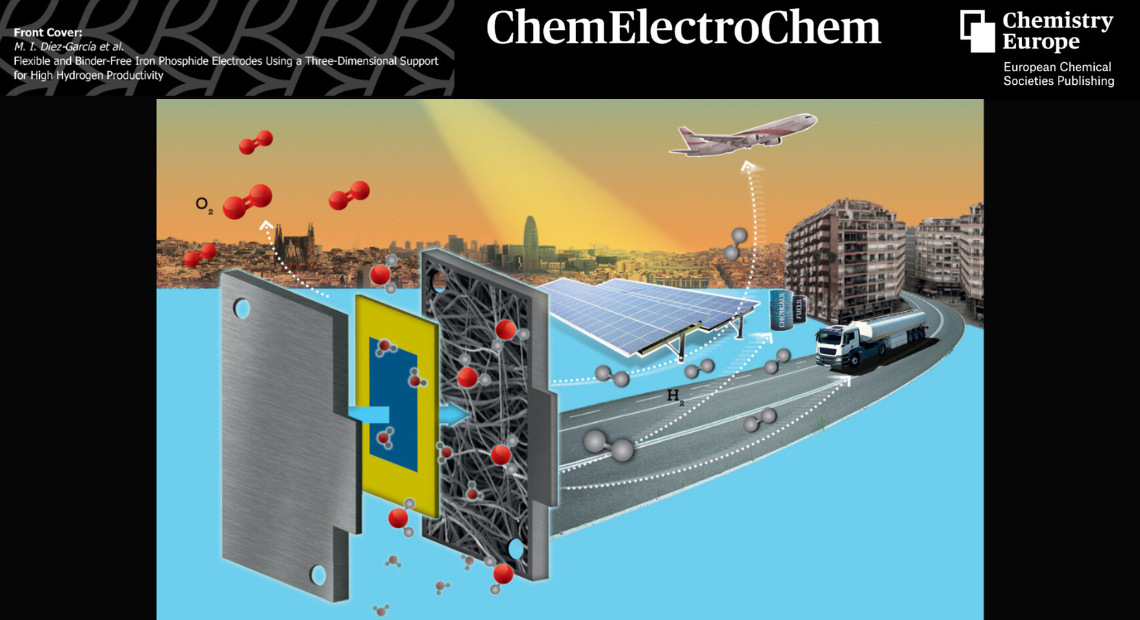The ChemElectroChem Journal has published a front cover to highlight new concepts about “Flexible and Binder-Free Iron Phosphide Electrodes Using a Three-Dimensional Support for High Hydrogen Productivity”, showcasing recent advancements in sustainable energy solutions recently developed. This work is the result of a collaborative endeavour between IREC’s Energy Storage, Harvesting, and Catalysis group and researchers from Catalan Institute of Nanoscience and Nanotechnology (ICN2) and King Fahd University of Petroleum and Minerals (KFUPM). It spotlights an innovative approach that significantly enhances hydrogen production, representing a major milestone in our collective task towards a more sustainable future.
The highlight presented in this cover feature is the introduction of flexible, binder-free iron phosphide electrodes designed for cost-effective and highly efficient hydrogen production. These electrodes based on abundant and non-expensive elements, when incorporated into an electrolyzer, demonstrate a remarkable capability to produce efficiently hydrogen at high accelerated rates. The key to this innovation is the integration of a three-dimensional support, ensuring an expansive active surface area for the electrode. This intricate design facilitates high current densities, higher than amperes/cm2, all the while maintaining impeccable stability, establishing a new industry standard.
Hydrogen, frequently touted as the energy solution of the future, has the potential to revolutionize sectors from renewable energy to broad industrial and transport applications. The essence of this work is not just to enhance our understanding of this electrode catalyst, but to provide a blueprint for realizing their maximum potential. The implications are significant, indicating a future enriched with advanced energy storage solutions, fostering environmentally friendly and economically sound processes that benefit both industries and society.
The journal’s cover art offers a compelling narrative: an electrolyser powered by solar panels, producing green hydrogen. This sustainable hydrogen variant has a range of uses, from serving as a base for added value chemicals to fuelling urban transport. The illustration of Barcelona’s skyline in the background symbolises a vision where cities harness hydrogen for a multitude of purposes, spanning from transportation to industrial operations.
The horizon is promising for IREC’s Energy Storage, Harvesting, and Catalysis group. Their research spans a myriad of energy storage and conversion avenues. From cutting-edge batteries and supercapacitors to innovative green fuels, the team is leading the charge towards a decarbonised future without fossil energy sources. Their initiatives in electrochemical CO2 reduction and the novel method of transforming nitrogen compounds into ammonia highlights their dedication to sustainable practices.
The cover’s concept and initial draft were crafted by Dr. María Isabel Díez-García. The final cover profile is a collective achievement, with significant contributions from Dr. Andrés Alberto García Blanco, Dr. Sebastian Murcia-López, Marc Botifoll, ICREA Prof. Jordi Arbiol, Dr. Mohammad Qamar, and Prof. Joan Ramon Morante. The final graphic design was realised in collaboration with ec.lluch studio.
For more information about this front cover, access the full article here.
The initiative has been bolstered by funding from the European Union’s Horizon 2020 research and innovation programme and the Government of Catalonia’s Agency for Business Competitiveness (ACCIÓ).



